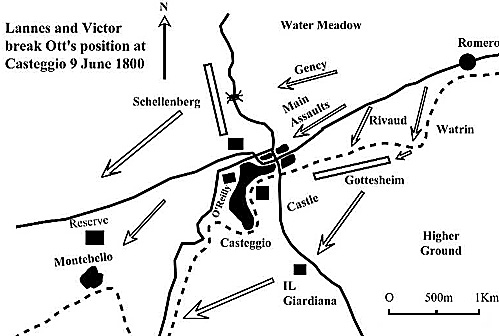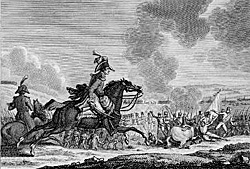Battle of Casteggio - Montebello
9th June 1800
1400:
The Second French Line Arrives
by Dave Hollins, UK
| |
At 1400, General Victor (at right) arrived with Rivaud's brigade. He immediately appreciated the dangers right across the frontline. The immediate problem was Vogelsang's troops in the hills, driving the French troops back down the slopes. General de Brigade Oliver Rivaud with 43è demi-brigade were directed off the road to the left, where Rivaud initially tried to rally Watrin's men. The quantity of metal shot coming from the Austrian line was making an uphill assault very difficult, necessitating a change of formation: Rivaud deployed the 43è with the 3rd Battalion in the centre in a column and the other two battalions dissolved en tirailleur (skirmish order) to either side, thereby reducing the depth of the target while maintaining some solidity. To the left of Rivaud, Mainoni took up the advance once again with 28è demi-brigade, who had never entirely disengaged. Rivaud launched his fresh troops against Vogelsang's weary infantry who had been in action for two hours, while behind him, Watrin's equally tired battalions formed up in reserve with 22è demi-brigade, to offer what support they still could. Victor had also noticed the diversionary effect of the 6è Légère, out in the watermeadows north of the village, although they don't appear to have a crossing point as yet. Schellenberg's infantry were now deploying and the Austrian position around Cssteggio was considerably shored up. Austrian fire continued to fall on the single battalion of 22è demi-brigade remaining near the blood-soaked Lannes, who held the road with the artillery and hussars. Reinforcing the French right would both help them and also force Ott to move more troops into that area, thereby preventing him from reinforcing Vogelsang in the hills. So, Victor sent the next unit arriving, 24è légère under Général Herbin, to march up to the north of the village. On the heights above Casteggio, Oliver Rivaud's intervention began to be felt as the initiative swung back to the French. He rode at the head of the 3rd Battalion formed in column, which he ordered not to fire but to continue advancing. Fire support came from the masses of tirailleurs detached on either flank. Valhubert and 28è demi-brigade now returned to torment the Austrian right once more. The ferocity of their attack was too much for the two battalions of IR17, which again buckled and shattered. Nevertheless, Vogelsang's line managed to retain some order as it retreated back down towards the narrow valley behind them. In the centre, the Leib (First) Battalions of IR57 Colloredo and 3. Ogulin Grenzers were putting up fierce resistance to hold their ground. As the French advanced, Rivaud and the 43è found themselves just 500 metres south-east of Casteggio. Across the stream in front of him was the large walled farm complex of Casa Il Giardiana, which guarded a ford. The farm itself had just been hastily garrisoned by part of the Ottocac Grenzer Battalion, which had extended out of Casteggio village to help the right wing. Determined to clear this obstacle, Rivaud ordered the first two companies of the 43è demi-brigade to take the mini fortress. They stormed in and after a desperate hand-to-fight with accurate French supporting fire, 150 Croats lay dead. As the Austrian right was driven back across the undulating hills south of Casteggio, the shattered IR17 continued to lose prisoners, totaling 345 at the end of the day. IR18 Stuart was also losing prisoners as FML Vogelsang now found himself outflanked on both sides. Although he would be leaving the way open for Rivaud to sweep round into the rear of Casteggio, he had to withdraw on to the next line of hills towards the upper Coppa. To allow the artillery to escape, 2nd Battalion IR57, made one last defiant stand as the French left, supported by Watrin, pressed forward. Nevertheless, Rivaud had now cleared the obstacles in the hills and could now begin his advance into the rear of Ott's position.totaling 345 at the end of the day. IR18 Stuart was also losing prisoners as FML Vogelsang now found himself outflanked on both sides. Although he would be leaving the way open for Rivaud to sweep round into the rear of Casteggio, he had to withdraw on to the next line of hills towards the upper Coppa. To allow the artillery to escape, 2nd Battalion IR57, made one last defiant stand as the French left, supported by Watrin, pressed forward. Nevertheless, Rivaud had now cleared the obstacles in the hills and could now begin his advance into the rear of Ott's position. O'Reilly's troops were still holding Casteggio village, where Ott now appreciated that Lannes was spearheading the Army of the Reserve's advance. With his right wing under severe pressure, Ott needed to consolidate a defensive position in the village. Advancing down the road, Lannes was surprised to see O'Reilly's Light Battalions evacuating the eastern buildings, which only served to spur his men on. As 24è Légère were marching across the fields north of the road, Lannes decided on a renewed assault on the bridges. The demi-brigade was quickly formed into assault columns. This time, the first bridge was clear, but beyond stood an Austrian battery, whose canister fire had already inflicted severe casualties on Lannes' force. Instead of continuing to charge along the winding main road, Sergeant Mayeux and 25 chasseurs from the 1st Battalion of 24è ran straight at these guns, sending their crews scuttling for cover. The way was now open for the rest of the unit following up behind to charge through the village square. Turning right on the road, they headed towards the second bridge, running straight into another shower of canister. Lannes would never forget the sound as "the bones cracked in my division like glass in a hailstorm." In repeat of the earlier attack, Schustekh led his cavalry forward to surround the head of the column, driving them back out of the village. The 12è Hussars charged again to support 24è Légère, but eventually the battered light infantry fell back into the village. The fire from Schellenberg's battalions north of the village plus the 16 artillery pieces (Schellenberg's battalion guns and O'Reilly's Cavalry Artillery battery) had been the major factor in halting the French attack. As 24è Légère moved to the right of the second bridge they could directly engage part of IR28 At the same time, 6è Légère had located a small bridge over the lower Coppa and were moving north to secure it. From the Austrian bank, FML Schellenberg could see the French light infantry moving across the water meadows. Although his men were in a good defensive position behind the Coppa River, the French were threatening to outflank the Austrian left. To protect his flank, IR 40 were moved north across the floodplain to counter Gency and by moving beyond the bridge, to maintain a flanking fire on the French right and anyone trying to cross the bridge. As 24è Légère engaged IR28, there was firing along the entire line. Ott's line was now spread very thin and his right wing was crumbling. Behind the French lines, the last of Victor's reinforcements, 96è demi-brigade were now advancing down the main road towards the village. The 3rd Battalion of 96è were quickly moved up to support the two battalions of 6è Légère on the Coppa. On the hills above Casteggio, FML Vogelsang's exhausted troops were being steadily driven back by over half of the overall French force. Cut off from the village by Rivaud with 43è, they fell back along the local tracks towards the upper Coppa in some disorder. FML Ott knew he had to withdraw from Casteggio before he was overwhelmed. To cover the retreat, Schellenberg ordered his five battalions at Montebello to come up as quickly as possible. At the double, the last Austrian reserves moved up, but at such breakneck speed that by the time they arrived they were half winded and unable to take effective offensive action. IR51 Splenyi's two battalions moved north in support of IR28 and IR40, while IR13 headed into the upper village. They didn't have enough time to deploy properly before the French tide engulfed them. Out on the French right, Gency with his three battalions was strong enough to cross the bridge suddenly, heading right between the two Austrian regiments. Having moved too far north, IR 40 were quickly cut off and almost surrounded, as IR28 was again assailed by 24è légère. Both Austrian wings were now broken and the French were about to envelop Casteggio. Ott ordered his troops to fall back to a defensive position at Montebello. O'Reilly's brigade with their single Cavalry artillery battery would form the rearguard to hold Casteggio. As he saw the firing lines advance on both flanks and the Austrians beginning to pull out of the village, Lannes decided to smash through the centre of the Austrian position at Casteggio village. The two battalions of 96è demi-brigade, who had only recently arrived, would be hurled at the defenders around the second bridge to rupture the Austrian position completely. They formed up in a deep column on the road to attack the village. The pas de charge was ordered and under a hail of canister, the 96è charged with bayonets lowered, straight down the main road. Under continuous fire, the French troops in the center stormed over the bridges as Rivaud was descending from the hills. Led by the remains of the Ottocaner Grenzer, the Austrian rearguard put up a murderous fight in the village. The Grenzers sustained heavy losses, but as French troops approached the road to the rear of the village, O'Reilly's rearguard were likewise forced to evacuate Casteggio covered by the guns. In the upper part of the village, IR13 Reisky continued to hold their positions as Rivaud's men swept past. To the north, the 96è were chasing O'Reilly's Light Battalions down the road towards Montebello. Finding their line of retreat blocked, 22 officers and 528 men of IR13, led by Major Czerwenka, fought their way out, but the remaining four hundred others had no option to surrender, as French troops poured into the village on all sides.  More Battle of Casteggio-Montebello 9th June 1800
Outpost Clashes East of Casteggio 1400: The Second French Line Arrives French Evening Advance to Montebello Order of Battle Back to Table of Contents -- First Empire #53 Back to First Empire List of Issues Back to MagWeb Master Magazine List © Copyright 2000 by First Empire. This article appears in MagWeb (Magazine Web) on the Internet World Wide Web. Other military history articles and gaming articles are available at http://www.magweb.com |
